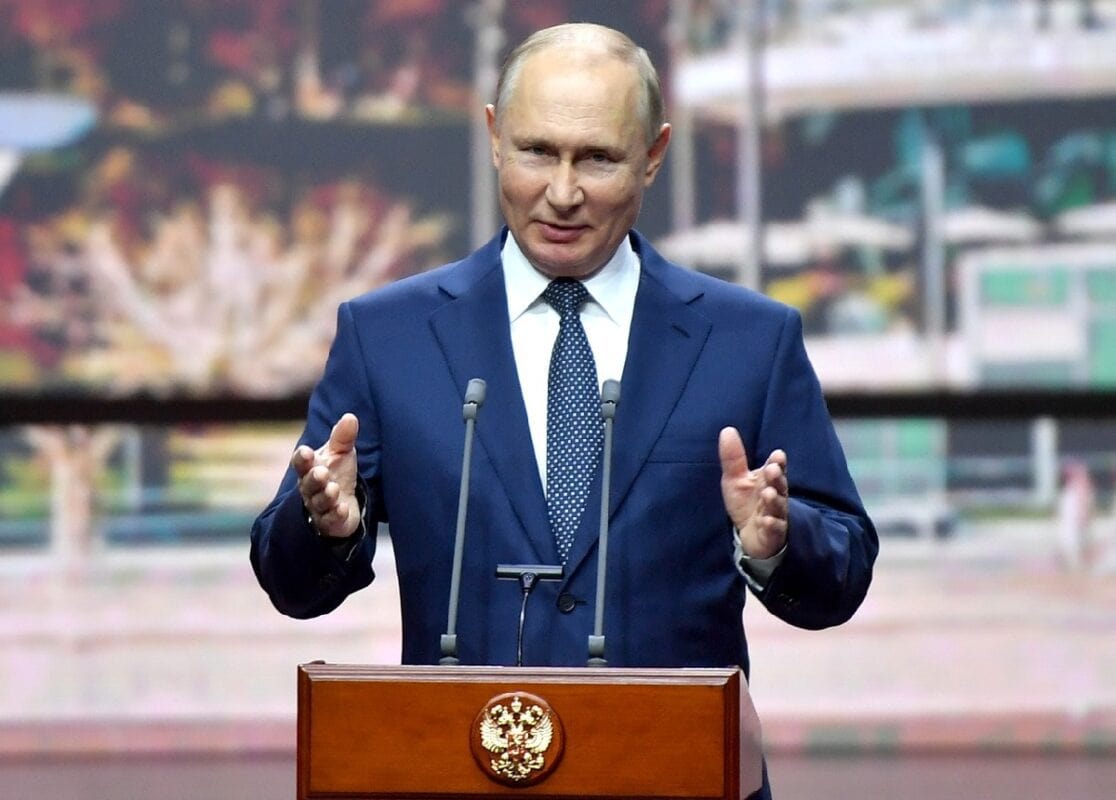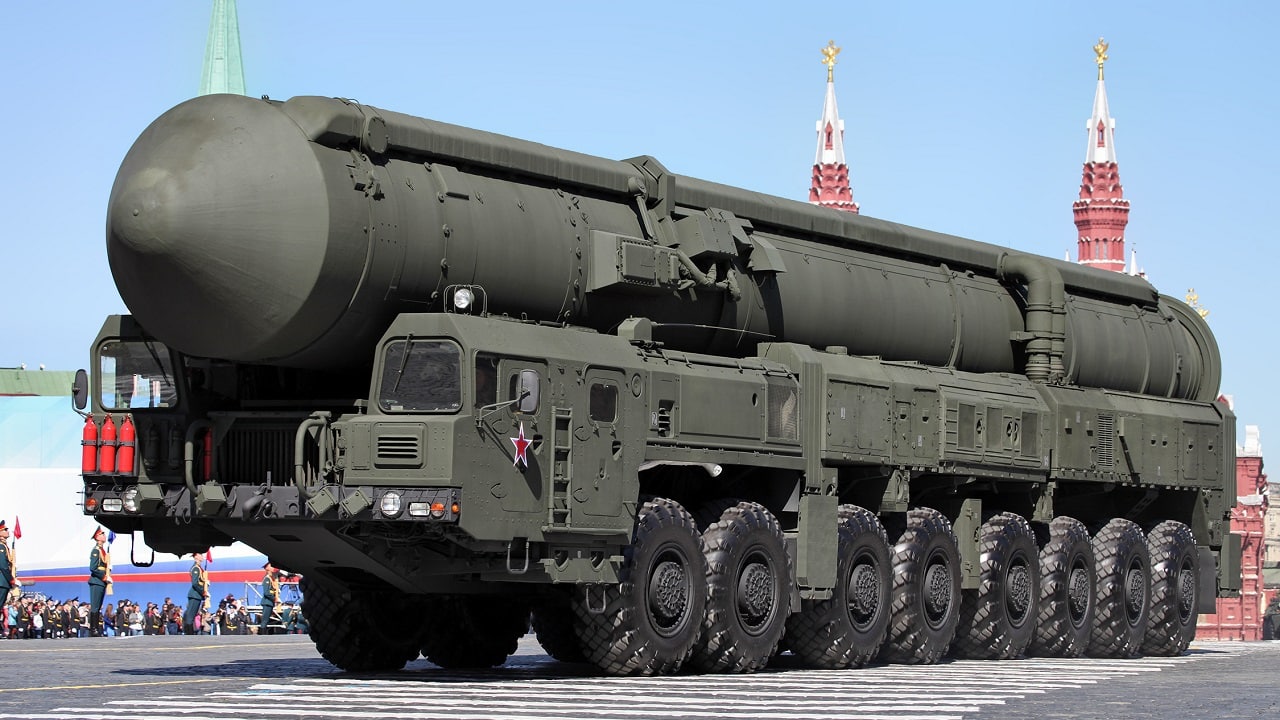With an estimated 100,000 Russian troops positioned near Ukraine’s border and President Biden promising to assist Ukraine against a Russian invasion, the risk of nuclear weapons use is once again on the rise. During the Cold War, intercontinental ballistic missiles (ICBM), long-range strategic bombers, and submarine-launched ballistic missiles (SLBM) were the primary threat to human civilization. Today, however, it is Russia’s low-yield short-range battlefield nuclear weapons that pose the greatest nuclear threat.
Unlike strategic nuclear weapons like ICBMs and SLBMs, which have a range of more than 10,000 miles and yields above 150 kilotons, battlefield nuclear weapons are primarily short-range (less than 650 miles) and low yield (.1 to 20 kilotons). The Russians maintain an estimated 3,000-6,000 intra-theater nuclear weapons—many of which fall into this category. The United States, however, has no similar arsenal of battlefield nuclear weapons.
Russian Strategy
In recent years, Russian nuclear weapons were integrated into the nation’s defense posture in much the same way the United States integrated nuclear weapons into its defense of Europe during the Eisenhower administration under the New Look Policy. President Vladimir Putin’s comments concerning his willingness to use nuclear weapons confirm fears that he views nuclear weapons as usable weapons on the battlefield.
Exercises such as GROM-2019 incorporated the use of both Russian strategic and battlefield nuclear weapons with dual-use delivery platforms. ZAPAD 2021 also featured strategic and battlefield nuclear weapons—along with over 200,000 Russian and Belarusian troops. According to one analysis, during ZAPAD 2021 the Russian Strategic Rocket Forces potentially simulated a nuclear attack against NATO.
Prior to the recent move of Russian forces to Ukraine’s border, our analysis suggested that the United States and NATO might face a limited Russian nuclear strike in the wake of a Russian invasion of Baltic NATO member-state, like Estonia, where an American-led relieving force is moving East to expel Russian forces. For the sake of understanding just how usable battlefield nuclear weapons are, we offer the following scenario as an example of what is possible in a variety of different circumstances.
Home to Russia’s Baltic Fleet, interceptor aircraft, and heavy armor, Kaliningrad is also home to Russian battlefield nuclear weapons. Kaliningrad is geographically suited as a military stronghold from which Russia can launch a limited nuclear strike. Public statements by President Putin suggest he will use low yield nuclear weapons on the battlefield if Russia is losing a conventional conflict to NATO forces. This “escalate to deescalate” strategy is designed to create a fiat acompli in which NATO backs down after the use of nuclear weapons.
Since NATO and the United States do not possess a similar spectrum of battlefield nuclear weapons, it should come as no surprise that Russian strategy is designed to exploit that advantage. Russia cannot match NATO’s conventional capability.
Understanding Nuclear Weapons Effects
For this scenario, we assume Russia’s objective in using a nuclear weapon is to demonstrate resolve and escalate a conventional conflict to a point where NATO and the United States capitulate to avoid further escalation. We assume Russia detonates a 10-kiloton nuclear weapon in a rural area ahead of advancing NATO forces.
Such a burst would be smaller than either the Little Boy (15 kilotons) or Fat Man (20 kilotons), which were dropped on Hiroshima and Nagasaki in August 1945, but large enough to clearly signal escalatory intent. What makes such a nuclear weapon’s use unexpectedly shocking is how little damage it may potentially cause.
Using the formulae found in Samuel Glasstone and Philip Dolan’s The Effects of Nuclear Weapons, some interesting results present themselves. First, if the Russians were to detonate their 10-kiloton nuclear weapon at a height of burst 587.6 feet above ground level, the ensuing fireball would not reach the ground. Thus, this “fallout free” detonation would not create the nuclear fallout zone that many Americans think results from a nuclear detonation. It would essentially result in a “clean” detonation.
Second, if the weapon were detonated above a rural area in front of advancing American troops, the prompt ionizing radiation (beta and gamma) released from the nuclear blast (deadly to humans) would dissipate within a radius of less than one thousand yards in less than a minute. This means exposed troops marching down a road could be very close to the detonation without receiving a harmful dose of ionizing radiation. If protected inside vehicles, buildings, or foxholes, the minimum safe distance from the detonation is even closer.

Russian President Putin. Image Credit: Creative Commons.
Because the detonation described here is a “fallout free” air burst, there is no debris field that poses a radiological threat to American troops. Radiological debris occurs when a “ground burst” sucks material from the ground into the blast cloud, where it is irradiated, and deposits radiological debris back on the ground.
According to our analysis, even if the 10-kiloton detonation were a ground burst, NATO troops would only be required to maneuver one thousand yards to safely move around an irradiated ground zero one day after detonation. Doing so would see an unprotected soldier receive .41 rems of radiation. Considering that a CT scan generates about 1 rem of radiation exposure, the low radiological threat of such a weapon makes its use more feasible.
Third, the blast wave (overpressure) that crushes structures also dissipates after less than one thousand yards. Again, if used as a demonstration strike to signal Russian resolve, the blast wave’s destructive effects in a rural area would cause little damage.
Fourth, the intense thermal radiation (x-ray) released in our theoretical nuclear blast dissipates in a radius of less than one thousand yards and in about one second. Given the location of our demonstration strike, there is limited damage and death due to heat or fire. This contrasts greatly with the examples of Hiroshima and Nagasaki, which were cities largely comprised of wooden structures. It is important to note that it was fire that caused the majority of death and damage in both cities—not radiation.
Plausibility
Advocates of arms control will certainly take issue with our suggestion that adversaries believe it is possible to contemplate the discreet and limited use of nuclear weapons, but the reality is that Vladimir Putin and the Russian leadership believe they have created an asymmetric advantage with their large arsenal of low-yield battlefield nuclear weapons. Denying and mischaracterizing the threat will not make it go away.
The Russian military has the capability and will to use nuclear weapons in limited strikes that are unlikely to lead to full scale nuclear war. If the Russians questions American resolve to trade New York for Berlin, how much more do they question our resolve to trade New York for a cow pasture in northeast Poland? For the Russians, American capability is not in question; it does not exist. It is American will that is under assault.
However, the United States can take effective measures to develop both the capability and will to deter Russian use of battlefield nuclear weapons.
Recommendations
First, it is time for NATO to declare Russia an adversary of the alliance. Absent a clear adversary, it is impossible to effectively plan for deterring or defeating the Russian threat. Making it clear to President Putin that the alliance takes the Russian threat seriously, may signal a level of NATO resolve lacking since the Soviet Union’s collapse. It may also shift the thinking about the nuclear mission of dual-capable aircraft (DCA) in NATO—shifting the purpose of the approximately 150 B61 nuclear weapons in Europe from political tools to weapons of war.
Second, the United States and NATO should invest the time and money required to ensure the alliance’s B61-armed fighter jets maintain readiness rates that allow them to perform the tactical nuclear mission on twenty-four hours’ notice, rather than the months-long schedule. Developing tactics, techniques, and procedures for operating against modern Russian forces are also needed as the nuclear mission shifts from political to operational. Given the domestic politics of some NATO member-states, shifting DCA aircraft and weapons to countries less opposed to nuclear weapons may be necessary. Countries closer to Russia often feel the Russian threat most pointedly.
Third, it is time for the United States to develop a new nuclear-armed ground-launched cruise missile (GLCM II) and medium-range ballistic missile (Pershing III) for deployment in the European theater. Taking a page out of President Ronald Reagan’s playbook in dealing with the Soviet Union prior to the Intermediate Nuclear Forces (INF) Treaty (1987) would go a long way to promoting stable deterrence in Europe. The United States already has the technical capacity to field such weapons and could do so with relative speed.
Admittedly, the Biden administration is under significant pressure from well-funded arms control groups to reduce the size and role of the nation’s nuclear arsenal in the next Nuclear Posture Review. For many of the groups seeking to shape the Biden administration’s nuclear policies, the elimination of nuclear weapons is akin to a religious tenet and is divorced from any strategic assessment of threats and risk. Thus, it is unlikely the President would approve the development and deployment of new nuclear weapons.
However, promises of “integrated deterrence” are unlikely to achieve the desired effects as there is simply no substitution for nuclear weapons. Allowing Russia, and China, to develop nuclear arsenals that are larger and more diverse than the United States’ creates an asymmetric advantage for our adversaries that is not overcome through diplomatic, informational, or economic means. For authoritarian regimes, the language of power is often the only language spoken. Former Secretary of Defense Donald Rumsfeld was correct when he said, “Weakness is provocative.” The United States can no longer wish away the problem.
James Ragland is a bioenvironmental engineer and a 15-year veteran of the United States Air Force. Since 2004, he has been a faculty member of the Defense Nuclear Weapons School, the nation’s premier nuclear and radiological education institution. Mr. Ragland is considered a subject matter expert in nuclear policy and deterrence, nuclear weapons subjects to include design and effects, and nuclear proliferation. He also serves as manager of the nation’s most complete classified nuclear weapons museum
Dr. Adam Lowther is Director of the Department of Multi-Domain Operations at the Army Management Staff College where he leads education and research in that area. He was Professor of Political Science at the US Army’s School of Advanced Military Studies (SAMS), he taught Twenty-first Century Conflict to senior service college students in the Advanced Strategic Leadership Studies Program. He is an expert in nuclear deterrence, multi-domain operations, and the nuclear programs of Russia and China.
The views expressed are those of the authors alone and do not necessarily represent those of the United States Government.

